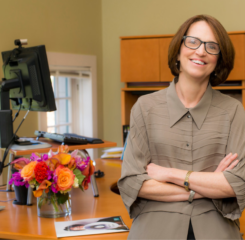LPC Advisory Group: Market Growth and Opportunities
Dan Hermann, President and CEO of Ziegler, as well as Lisa McCracken, Director of Senior Living Research and Development led the presentation with an examination of key market trends for aging services providers. Among many key observations, Dan discussed the projected dramatic increase in demand for LPCs between 2015-2050, and noted that the fastest growth in the sector – especially in new community development – is in the for profit CCRC cohort. He commented on the “pruning the tree” effect of the many dispositions and sponsorship changes that have happened in the last few years, and urged organizations to consider opportunities to merge, especially if they are small or struggling. Lisa concluded this portion of the presentation with other statistics on growth, including the fact that the multi-site providers are showing the most growth, and that overall, not for profits are down to 1% from 5% pre-recession in terms of market presence. Later in the presentation, Dan made an especial observation that capital borrowing is at historic lows in terms of interest rates, especially in municipal bonds, and that the time has never been better for not for profits to borrow capital to expand and grow. (With gratitude: Ziegler is a LeadingAge Gold Partner.)
Nicole Fallon, LeadingAge’s Vice President of Health Policy and Integrated Services, spoke next on the topic of Medicare Advantage (MA) plans. She opened by explaining that Medicare beneficiaries have a choice of how to use their benefit, and more are choosing to enroll in MA plans. Organizations have an opportunity to become a “pay-vider:” both a payer and provider of MA. The consumer benefits of an MA plan include predictable costs, a greater awareness of options available for care, a maximum out of pocket spend on healthcare, and access to coverage in the areas of vision, dental and hearing. Nicole shared a chart that, among many things, showed that 44% of Medicare dollars are in MA and special care plans. Special care plans, as a subset of MA, offer care coordination and the integration of dual eligible benefits. She explained ISNPs and CSNPs, and shared that more than one third of ISNP programs are run by long term care providers. Nicole closed with a discussion on the pros and cons of joining with partners to run MA programs, and talked about the core leadership competencies needed to undertake the growth of an MA plan in an organization’s portfolio.
Continuing Care at Home was the next topic, and was discussed by Brad Paulis, a partner at Continuing Care Actuaries. Brad discussed the advantages of establishing a CC@H program as an LPC, and emphasized that the consumers of a CC@H are not the same as that of a CCRC. Because there is now $400 billion for HCBS in the recent infrastructure package, Brad noted that now is a great time to get into CC@H. He also pointed out that starting a CC@H helps an organization diversify their overall risk, as more individuals are added to the pool of persons served and insured. (With gratitude: Continuing Care Actuaries is a Business Partner of LeadingAge.)
Joanne Handy, a strategic consultant and former CEO of LeadingAge California, concluded the program with a discussion on board development for strategic growth. Joanne spoke about prioritizing the options for strategic growth by scale, scope and spread, and gave examples of each. She encouraged boards to engage in hypothetical conversations about their preparedness for mergers and acquisitions, and urged boards not to wait until it’s too late to seek an M&A and all the desirable partners are taken.
A group discussion then followed, and Dee Pekruhn asked the panelists to discuss what the greatest barriers to growth are for LPCs, as members on the call were asked to do the same in the chat. Repeatedly, chat participants identified “workforce” and staffing issues as a great barrier to growth. Dan discussed securing zonable land; Lisa mentioned both workforce and risk tolerance as barriers. Nicole’s response was concerned with having the funds to invest up front in new projects like MA, and partnering. Brad talked about the need for more entrepreneurial boards and the need for organizations to diversify their risk portfolios. In closing, Joanne talked about the need for growth-resistant boards to engage in hypothetical conversations about future planning.
The call ended with a poll about participant’s satisfaction with the session; the majority rated the call as either ‘excellent’ (67%) or ‘outstanding’ (22%). Members offered helpful suggested for both the structure and content of future calls.
The next LPC Advisory Group meeting will be on Wednesday, September 29 at 2:00 PM EST, and will focus on the Middle Market. Beth Mace, NIC, Colin Milner, ICAA and Melissa Andrews, LeadingAge Virginia, will be panelists. Members may register by emailing Dee Pekruhn at dpekruhn@leadingage.org.

Most Recommended
October 15, 2025
 Shutdown Week Three: Impact of Ongoing Closure on Affordable Housing
Shutdown Week Three: Impact of Ongoing Closure on Affordable Housing
December 10, 2025
Fiscal Year (FY) Funding 2026
October 07, 2025
Immigrant Workforce Matching Program Brings Workforce Relief
Recently Added
December 11, 2025
 Analysis: CY2026 Home Health Final Rule
Analysis: CY2026 Home Health Final Rule
December 09, 2025
Collaborating Around the Globe to Teach and Learn
December 08, 2025



